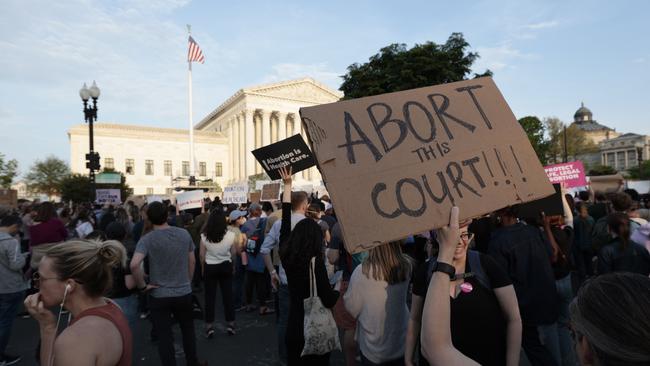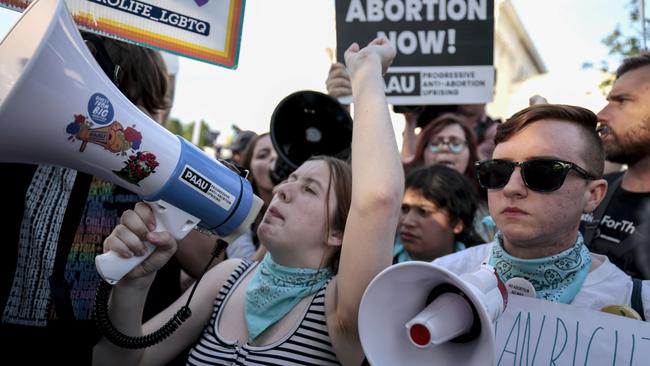What a Supreme Court ruling on Roe v Wade would mean for women
If the court overturns Roe, it would represent the biggest shift in reproductive healthcare in 50 years.

If the Supreme Court overturns Roe v. Wade, it has the potential to immediately transform the reproductive lives of women in roughly half the country, and would represent the biggest shift in reproductive healthcare in 50 years.
Nearly half the states in the U.S. have passed bans on most abortions that are poised to take effect soon after the court overturns Roe — while more than a dozen others recently have moved to protect abortion rights in state laws. The Supreme Court has yet to issue a final ruling deciding whether to overturn the 1973 decision that created a federal constitutional protection for abortion. A draft opinion written by Justice Samuel Alito and leaked Monday explicitly called for Roe to be overruled.
In front of the Supreme Court Tuesday, protesters brandished coat hangers, invoking images of back-alley abortions from the period before Roe v. Wade, when obtaining an abortion illegally or administering it oneself carried the risk of infection, hemorrhage and even death.
But doctors and abortion providers say the procedure looks very different for many women now. The Food and Drug Administration two decades ago cleared the way for a two-dose medication regime that causes abortion. More than half of U.S. abortions in 2020 were medication abortions, according to the Guttmacher Institute, a policy group that supports abortion rights and tracks national abortion statistics.

Self-managed, drug-induced abortions are safe but come with more risks if they aren’t overseen by a physician, said Carrie Cwiak, an abortion provider and professor of obstetrics and gynecology at Emory University in Atlanta. “Someone shouldn’t have to resort to that,” she said. “If they do, they’re probably going to be fine. Is it ideal? Are they going to come to the emergency room for bleeding? What if they’re too far along? We have to think about: Is there potential for misuse? Yes, there’s potential for misuse.”
Legislators in Kentucky, Missouri and elsewhere have passed or proposed legislation to more tightly regulate medication abortion, but groups on both sides say regulating the flow of pills purchased online and sent from out-of-state or abroad is challenging.
Antiabortion groups said they are also preparing for the decision so they can assist women who decide to carry their babies to term. Some say they are planning to open additional centers and plan to fundraise to buy more diapers, formula and other supplies.
Kathleen Wilson, founder and executive director of Mary’s Shelter in Fredericksburg, Va., a maternity home, said it is preparing for the possibility that it might need to serve more pregnant women. The group, which currently has 16 bedrooms to house pregnant women and children, is opening another location with eight additional bedrooms because it already sometimes has to house families in hotels, on couches or in dining rooms because it doesn’t have enough space.
“If the numbers get greater, which they may, then we know that we have amazing donors who love what we do and we know they’ll step up and we will continue to grow the ministry, like we’ve been doing over the last 15 years,” Ms. Wilson said.
The number of abortions has been trending downward for years. In 2017 — the latest data available — the abortion rate in the U.S. reached its lowest level since it became legal across the country with 13.5 abortions for every 1,000 women ages 15 to 44 in the country, according to the Guttmacher Institute.
Groups on both sides say they anticipate that the number of abortions will drop further and births will tick up.
Some abortion providers said they are also concerned about an increase in maternal mortality if women carry more risky pregnancies to full term. Virtually all abortion bans have an exception for the life of the mother, but providers said that can be a gray area. “Abortion can be at times the only way you can save their lives,” said Dr. Beverly Gray, who oversees the residency program at Duke University’s obstetrics department and who said her grandmother’s life was saved by an abortion after she was diagnosed with cervical cancer in the 1970s.
Women could also start traveling in greater numbers across state lines to obtain abortions.
Whole Woman’s Health, an abortion provider with four clinics in Texas and others in Indiana, Maryland, Minnesota and Virginia, started a new service following the passage last year of a restrictive Texas law known as SB8 to help patients travel across state lines, setting them up with hotel accommodations, child care and other costs, said Amy Hagstrom Miller, president and chief executive of the group.
The organization also has increased staff and doctors at clinics in Virginia, Maryland and Minnesota, where access to the procedure will likely persist. Doctors have been getting licensed to work in other states, she said, and the organization has added more physicians to its virtual care options. Ms. Miller said she is looking at expanding bricks-and-mortar locations as well.
In a March Wall Street Journal poll, 46% of women supported banning abortions after 15 weeks and 49% of men did. Twenty-nine percent of women and 24% of men said abortion should always be legal.
The Supreme Court hasn’t issued a final ruling in the case and abortion is still legal up until fetal viability, or around 22 to 24 weeks of pregnancy, in most parts of the country. Providers said they are concerned that the leak of the draft opinion will be enough to sow confusion. They said they have been using social media and other tools to alert patients that clinics are still open.
— Andrea Petersen contributed to this article.
The Wall Street Journal







To join the conversation, please log in. Don't have an account? Register
Join the conversation, you are commenting as Logout